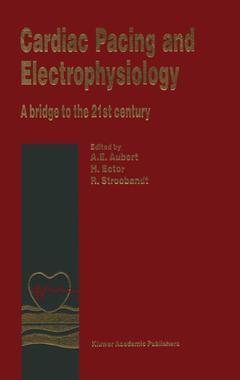L’édition demandée n’est plus disponible, nous vous proposons la dernière édition.
Cardiac Pacing and Electrophysiology, Softcover reprint of the original 1st ed. 1994 A bridge to the 21st century
Langue : Anglais
Coordonnateurs : Aubert André, Ector Hugo

In 1992, clinical cardiac electrophysiology became a recognized sub-speciality of the American Board of Internal Medicine. The formal recognition of this highly specialized and technical field of medicine represents the culmination of thirty years of remarkable scientific and intellectual discovery. Beginning in the 1950s, cardiologists realized that cardiac arrhythmias were the cause of significant morbidity and the sudden death of at least 350,000 patients every year in the United States alone. At that time the only tools available for analyzing abnormal heart rhythms were the standard EKG machine and careful deductive reasoning. During the early 1960s, cardiac pacemakers reflected the first foray in the electrical therapy of cardiac arrhythmias. Pacemakers were first implanted in order to control syncopal episodes related to bradycardic heart rhythms. Although crude and bulky devices, their utility was immediately obvious to physicians and patients alike. The recognition that electrical signals could be recorded from inside the heart and that the heart's rhythm could be controlled by the application of electrical energy began the era of clinical cardiac electrophysiology which was to follow. In the late 1960s and early 1970s and at the peak of the Vietnam conflict. a group of cardiologists with special training in cardiac electrophysiology were sequestered at the US Public Health Service Hospital at Staten Island.
Foreword. Part One: Electrophysiology. 1. Equipment for the electrophysiology laboratory; possibilities and limitations. 2. Vasovagal syncope: clinical presentation, classification and management. 3. Classification of antiarrhythmic drugs in relation to mechanisms of arrhythmias. 4. Electrophysiological characteristics in arrhythmogenic right ventricular dysplasia and dilated cardiomyopathies. 5. Classification of death in patients under antiarrhythmic treatment. 6. Heart rate variability. Methodology and physiological basis. 7. Heart rate variability and QT interval: their relationship with the cardiac frequency. 8. Role of dynamic QT interval in Holter tapes to stratify risk in postmyocardial infarction patients. 9. Heart rate variability in patients with angina pectoris. 10. Time and frequency domain analysis of heart rate variability after myocardial infarction. 11. Signal averaged ECG. Technical principles, possibilities and limitations. 12. Optimizing the predictive value of the signal-averaged ECG for serious arrhythmic events in the post-infarction period. 13. Signal-averaged analysis of the P wave: possible applications in different settings. 14. Late potentials during acute myocardial ischaemia. 15. Radiofrequency catheter ablation in the treatment of supraventricular tachycardias. 16. Anatomical versus electrophysiological approaches for ablation of the slow pathway in patients with AV nodal reentrant tachycardia. Part Two: Pacing. 17. Cardiac pacing in Europe in 1992: a new survey. 18. The myocardium-electrode interface at the cellular level. 19. The myocardium-electrode interface at the macrolevel. 20. Unipolar versus bipolar leads. 21. Single lead VDD pacing: an update. 22. Substantial improvement of screw-in electrodes. 23. Physiological cardiac pacing: an individual objective. 24. Pacemaker syndrome during atrial-based pacing. 25. Dual chamber pacemaker therapy in cardiomyopathy. 26. DDD rate-responsive pacing: state of the art. 27. Heart rate response based on changes in central venous oxygen saturation, minute ventilation and body activity. 28. DDDR and atrial arrhythmia. 29. Holter and pacemaker diagnostics. 30. Clinical relevance of histograms in the follow-up of DDDR-pacemakers. 31. Holter and telemetry in pacemakers and ICDs: new developments. 32. Automatic measure of the interface capacitor and the total cardiac impedance. 33. Critical analysis of the different algorithms designed to protect the paced patient against atrial tachyarrhythmias in dual chamber pacing. 34. Mode switching in DDDR pacing. Part Three: Defibrillators. 35. Indication for ICD implantation and selection of patients: present and future. 36. The optimum tilt for defibrillation. 37. Cerebrovasomotor reactivity predicts tolerance to tiered therapy with implantable cardioverter-defribillators. 38. Clinical utility of telemetered electrograms in pacemakers and ICD's. 39. High patient acceptance for implantable cardioverter/defribillator (ICD); quality of life and patient acceptance. 40. Cardiac pacing and electrophysiology: how much technology do we need? 41. Medical technology assessment and reimbursement policy of implantable device
Date de parution : 11-2012
Ouvrage de 441 p.
16x24 cm
Disponible chez l'éditeur (délai d'approvisionnement : 15 jours).
Prix indicatif 52,74 €
Ajouter au panierThème de Cardiac Pacing and Electrophysiology :
© 2024 LAVOISIER S.A.S.



